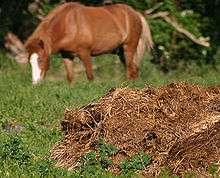Manure
Manure is organic matter that is used as organic fertilizer in agriculture. Most manure consists of animal feces; other sources include compost and green manure. Manures contribute to the fertility of soil by adding organic matter and nutrients, such as nitrogen, that are utilised by bacteria, fungi and other organisms in the soil. Higher organisms then feed on the fungi and bacteria in a chain of life that comprises the soil food web.

In the past, the term "manure" included inorganic fertilizers, but this usage is now very rare.
Types
There are in the 21st century three main classes of manures used in soil management:
Animal manure

Most animal manure consists of feces. Common forms of animal manure include farmyard manure (FYM) or farm slurry (liquid manure). FYM also contains plant material (often straw), which has been used as bedding for animals and has absorbed the feces and urine. Agricultural manure in liquid form, known as slurry, is produced by more intensive livestock rearing systems where concrete or slats are used, instead of straw bedding. Manure from different animals has different qualities and requires different application rates when used as fertilizer. For example horses, cattle, pigs, sheep, chickens, turkeys, rabbits, and guano from seabirds and bats all have different properties.[1] For instance, sheep manure is high in nitrogen and potash, while pig manure is relatively low in both. Horses mainly eat grass and a few weeds so horse manure can contain grass and weed seeds, as horses do not digest seeds the way that cattle do. Cattle manure is a good source of nitrogen as well as organic carbon.[2]Chicken litter, coming from a bird, is very concentrated in nitrogen and phosphate and is prized for both properties.[2][3]
Animal manures may be adulterated or contaminated with other animal products, such as wool (shoddy and other hair), feathers, blood, and bone. Livestock feed can be mixed with the manure due to spillage. For example, chickens are often fed meat and bone meal, an animal product, which can end up becoming mixed with chicken litter.
Human manure
Some people refer to human excreta as human manure, and the word "humanure" has also been used. Just like animal manure, it can be applied as a soil conditioner (reuse of excreta in agriculture). Sewage sludge is a material that contains human excreta, as it is generated after mixing excreta with water and treatment of the wastewater in a sewage treatment plant.
Compost
(NRCS_Photo_Gallery).jpg)
Compost is the decomposed remnants of organic materials. It is usually of plant origin, but often includes some animal dung or bedding.
Green manure
Green manures are crops grown for the express purpose of plowing them in, thus increasing fertility through the incorporation of nutrients and organic matter into the soil. Leguminous plants such as clover are often used for this, as they fix nitrogen using Rhizobia bacteria in specialized nodes in the root structure.
Other types of plant matter used as manure include the contents of the rumens of slaughtered ruminants, spent grain (left over from brewing beer) and seaweed.
Uses of manure
Animal manure
Animal manure, such as chicken manure and cow dung, has been used for centuries as a fertilizer for farming. It can improve the soil structure (aggregation) so that the soil holds more nutrients and water, and therefore becomes more fertile. Animal manure also encourages soil microbial activity which promotes the soil's trace mineral supply, improving plant nutrition. It also contains some nitrogen and other nutrients that assist the growth of plants.[4]
Manures with a particularly unpleasant odor (such as slurries from intensive pig farming) are usually knifed (injected) directly into the soil to reduce release of the odor. Manure from pigs and cattle is usually spread on fields using a manure spreader. Due to the relatively lower level of proteins in vegetable matter, herbivore manure has a milder smell than the dung of carnivores or omnivores. However, herbivore slurry that has undergone anaerobic fermentation may develop more unpleasant odors, and this can be a problem in some agricultural regions. Poultry droppings are harmful to plants when fresh, but after a period of composting are valuable fertilizers.[5]
Manure is also commercially composted and bagged and sold as a soil amendment.[6][7]
In 2018, Austrian scientists offered a method of paper production from elephant and cow manure.[8]
Issues

Any quantity of manure may be a source of pathogens or food spoilage organisms which may be carried by flies, rodents or a range of other vector organisms and cause disease or put food safety at risk.
Livestock antibiotics
In 2007, a University of Minnesota study[9] indicated that foods such as corn, lettuce, and potatoes have been found to accumulate antibiotics from soils spread with animal manure that contains these drugs.
Organic foods may be much more or much less likely to contain antibiotics, depending on their sources and treatment of manure. For instance, by Soil Association Standard 4.7.38, most organic arable farmers either have their own supply of manure (which would, therefore, not normally contain drug residues) or else rely on green manure crops for the extra fertility (if any nonorganic manure is used by organic farmers, then it usually has to be rotted or composted to degrade any residues of drugs and eliminate any pathogenic bacteria—Standard 4.7.38, Soil Association organic farming standards). On the other hand, as found in the University of Minnesota study, the non-usage of artificial fertilizers, and resulting exclusive use of manure as fertilizer, by organic farmers can result in significantly greater accumulations of antibiotics in organic foods.[9]
See also
- Album graecum
- Anaerobic digestion
- Chicken manure
- Coprophilous fungi
- Cow dung
- Dry animal dung fuel
- Earthen manure storage
- Liquid manure
- Manure spreader
References
- "Manure". h2g2. July 15, 2010. Retrieved 23 July 2017.
- Bernal, M.P.; Alburquerque, J.A.; Moral, R. (November 2009). "Composting of animal manures and chemical criteria for compost maturity assessment. A review". Bioresource Technology. 100 (22): 5444–5453. doi:10.1016/j.biortech.2008.11.027. PMID 19119002.
- Lustosa Filha, Jose; Penido, Evanise; Castro, Patricia; Silva, Carlos; Melo, Leonidas (September 4, 2017). "Co-pyrolysis of poultry litter and phosphate and magnesium generates alternative slow-release fertilizer suitable for tropical soils". ACS Sustainable Chemistry & Engineering. 5 (10): 9043–9052. doi:10.1021/acssuschemeng.7b01935.
- Das, Suvendu; Jeong, Seung Tak; Das, Subhasis; Kim, Pil Joo (2017). "Composted Cattle Manure Increases Microbial Activity and Soil Fertility More Than Composted Swine Manure in a Submerged Rice Paddy". Frontiers in Microbiology. 8: 1702. doi:10.3389/fmicb.2017.01702. ISSN 1664-302X. PMC 5591829. PMID 28928727.
- Thomas Bass, Julia Dafoe, and Joel Schumacher. "Manure Composting for Livestock & Poultry Production" (PDF). MontGuide. MT201206AG Reviewed 4/17.CS1 maint: multiple names: authors list (link)
- Wortman, Sam E.; Holmes, Ashley A.; Miernicki, Elizabeth; Knoche, Kaelyn; Pittelkow, Cameron M. (2017-07-08). "First-Season Crop Yield Response to Organic Soil Amendments: A Meta-Analysis". Agronomy Journal. 109 (4): 1210. doi:10.2134/agronj2016.10.0627. ISSN 0002-1962.
- https://wimastergardener.org/article/using-manure-in-the-home-garden/
- "Elephant and cow manure for making paper sustainably" (Press release). Science Daily. March 21, 2018. Retrieved March 30, 2018.
- Staff (2007-07-12). "Livestock Antibiotics Can End Up in Human Foods". ENS Newswire. Retrieved 2012-11-14.
External links
| Look up manure in Wiktionary, the free dictionary. |
| Wikimedia Commons has media related to Manure. |
- Application and environmental risks of livestock manure
- North American Manure Expo
- Cornell Manure Program
- County-Level Estimates of Nitrogen and Phosphorus from Animal Manure for the Conterminous United States, 2002 United States Geological Survey
- Manure Management, Water Quality Information Center, U.S. Department of Agriculture
- Livestock and Poultry Environmental Learning Center, an eXtension community of practice about animal manure management
- Antibiotics and Hormones in Animal Manure (Webcast): A two part webcast series about the science available on potential risks and best management practices related to antibiotics and hormones from animal manure